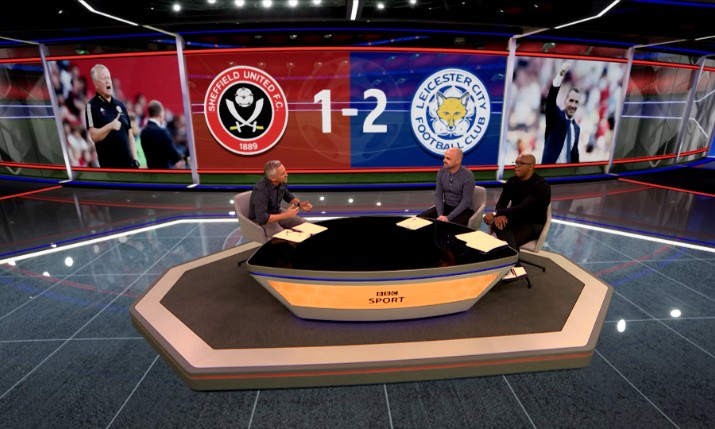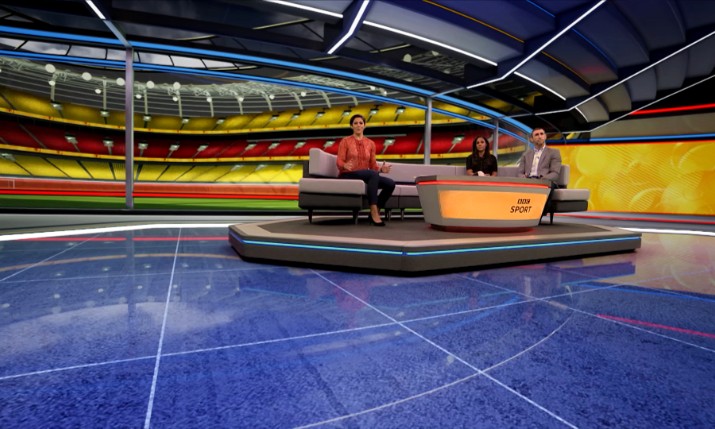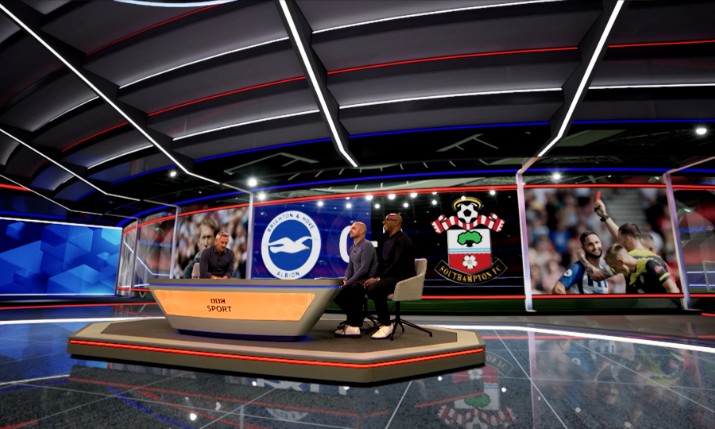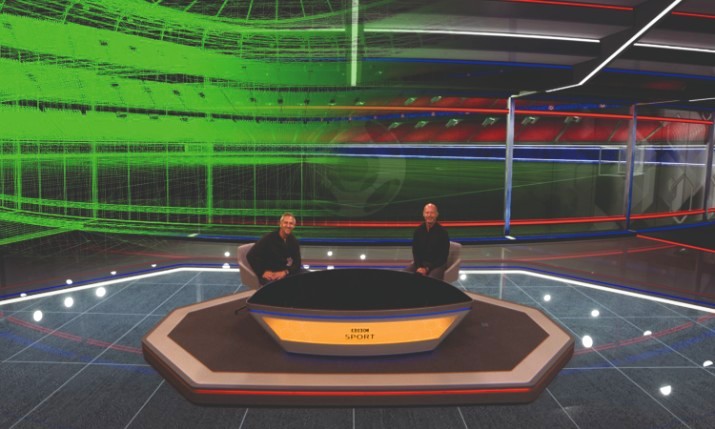Creating space: How (and why) BBC Sport turned to virtual reality for its football studio refresh

On Saturday 10 August, on the first weekend of the 2019-20 Premier League season, BBC Sport unveiled a new studio set for the presentation elements within its coverage of England’s top division.
Replacing a physical set that had been in use since 2011, the updated studio makes use of virtual reality (VR) set technology for the first time in many years and has become the new home of the highlights shows Match of the Day (MOTD) and MOTD 2, the live results show Final Score and the magazine programme Football Focus.
The decision to move from the physical world to the virtual one for the studio was not taken lightly, but it does promise several advantages, not least editorial flexibility, according to Charlie Cope, head of operations for BBC Sport.
“We definitely felt it was time to refresh the set as we have had it since 2011,” he says, speaking to SVG Europe.
“I wouldn’t deny that there was a lot of concern and scepticism at the beginning. But everybody has been extraordinarily engaged and on board. It’s been a real team effort to get it delivered.”
“We had to decide whether to rebuild and go with a new hard-set solution or to try something completely different. That set us on the road of working out what was achievable and what would be the justification for taking a change in direction.
“Clearly, one of the issues we have from an editorial perspective is that we have multiple strands across our football output. Up to now, we’ve always had a hard set that has some varying colours and a different identity for each of the different programme strands that use it.”
“We saw the potential in VR: we knew it could give us much more flexibility both creatively and editorially and would allow us to evolve the studio in the future. It didn’t just lock us into a new hard set that we would be stuck with for another five years.”
Ready for kick-off

Football Focus in its new home, presented by Eilidh Barbour
The project kicked off in earnest at NAB 2018 where the BBC Sport team first started looking seriously at virtual studio technology and began to evaluate it in its current form.
Having dabbled with virtual sets and studios in the past, including back in the 1990s when Football Focus was presented from inside a virtual football no less, it was clear that the technology had moved on significantly since then.
“The thing that has changed our view on VR is that it is now of a quality and level that allows [the virtual studio] to be photorealistic to a pretty convincing degree,” continues Cope.
“The quality of keying that you can now get, and all the shadow elements, give you a far more complete product. This was the game-changer for us. We suddenly realised that it was viable, and the technology was there to do it.”
The BBC is a public service broadcaster established by Royal Charter and funded by a licence fee that is paid by UK households. As a result, its spending is heavily scrutinised. The next big task, therefore, having pinpointed virtual tech and green screens as the preferred approach, was to look at the numbers and calculate whether or not it was financially viable.
“One of the positives [of moving to a virtual studio] was that we could reduce the size of the studio [we needed] and in doing so make savings that allowed us to fund the launch of the VR side. We also saw the potential for evolving the studio in a much more cost-effective way in the future.”
Working as a team
Being able to rent less studio space was certainly a benefit. But it is the partnerships agreed with two key suppliers that have been fundamental in making this new set possible, and affordable.
“We haven’t done this purely on our own,” acknowledges Cope.
“This has been done in partnership with Dock10 [BBC Sport’s studio facilities provider]. They were interested in getting into the world of VR studios. They felt it was something that could give them a significant USP in the studio market. So, we have done a joint investment in this with them. We’ve invested in it as a project and there are some upfront costs involved in that. They have invested in it from a technology perspective. Now they have VR studios expertise and systems that they can use and offer to other clients.”
Dock10 purchased the Mo-Sys camera tracking system StarTracker and the Zero Density Reality Engines that are being used and it has invested in the project from a training and operational point of view. The MediaCityUK-based company has also provided the 3D modelling VFX.
“As always in this kind of project, the initial creative ideas are right on the edge [of what is possible] and as you start to deliver the project you inevitably have to draw the boundaries of what you’re going to go live with.”
“They see it as something that they can benefit from in the future,” adds Cope. “That was a really important part of this project.”
Another important player is AE Graphics, the current graphics suppliers for BBC Sport’s football output.
“They’ve developed bespoke solutions for graphics management, for the operational interfaces and for handling all the AR elements in the real virtual space,” reveals Cope.
“And again, they’ve done that as a partnership with us. They see it as an investment that gives them a USP in the market and experience in this area. We’ve shared the development cost with them as a partner. Again, that’s been key.”
Cope is quick to praise both parties for their help.
“They’ve both been very supportive of what we’ve been doing. I very much hope they benefit from it as well. It’s been a very much a collaboration between the three parties to actually deliver [the VR studio].”

Clever set piece
From the BBC Sport side of things, the design of the set has been led by John Murphy, creative director, motion. He has done so working with AE Graphics, who also won the competitive tender for the design of the studio, and in collaboration with the directors of MOTD, Final Score and Football Focus.
The design aspirations were fairly broad: To deliver MOTD to a younger audience by incorporating the latest virtual technology and take it to the next level in terms of broadcasting; and to create a virtual set that looks very lifelike and takes the viewer on a new journey of football presentation.
The brief also asked for a 360-degree virtual set, including virtual ceiling and floor, and a large wrap-around screen, incorporating some of the regular strands of the programme.
“AE Graphics came up with the core design principles. John Murphy then worked very closely with them to actually deliver the final solutions,” says Cope.
It’s not just the look of the set and the move from physical to virtual that is different. How the studio is being used and operated has changed too.
“It can be quite a steep learning curve at times. But you don’t take on these kinds of projects without knowing you’re going to be faced with some fairly fundamental challenges.”
The new set makes use of a railcam, for example, mirroring what was done for presentation elements during the BBC’s coverage of World Cup 2018 in Russia.
“This gives us the reverse shots around the back of the studio We tested the concept quite extensively in Russia and that was very much a precursor to what we’re looking to achieve in the new studio. That work helped to drive the design piece.”
Augmented Reality (AR) graphics are also part of the editorial toolset in the new studio. AR is being used in the foreground and in a stadium backdrop to do team line-ups. The use of AR will evolve over the season, says Cope.
“As always in this kind of project, the initial creative ideas are right on the edge [of what is possible] and as you start to deliver the project you inevitably have to draw the boundaries of what you’re going to go live with.
“Clearly, we’re on air now and we are consolidating what we’re doing but there’s absolutely aspirations to continue to develop this as we go on. There are some areas that we know are fairly conservative but we’re pushing the technology quite heavily. You just have to be sensible about where you place those boundaries, certainly in the early days.”
Change the game

A wireframe of the new virtual set for Match of the Day
Implementing the new virtual set has also had an impact on operational practices within the production and studio team. The dynamic of the studio and how the studio runs and who the key players are, operationally, in the studio has changed quite radically.
As an example, the vision supervisor now has a crucial role in coordinating the studio environment. as there is, as Cope puts it, a “level of coordination and interaction between all the different elements that is suddenly vastly more complex.”
Camera operators have had to change their approach too, he adds.
“For a craft operator who would normally be independently minded, the camera is their domain and they are in total control. With a virtual studio set, you have to say to them: ‘Sorry, actually, you’re not in total control of this and there are certain things that you cannot do without talking to the vision supervisor first.’ It has changed the dynamic of all of those roles. It’s been fascinating to see how a fundamental change in technology is impacting on the way we run the studio.”
While a virtual studio set offers benefits and challenges, it has often divided opinion within the TV industry and the viewing public. It’s fair to say that not everyone has always been keen on the use of the technology.
“I wouldn’t deny that there was a lot of concern and scepticism at the beginning,” acknowledges Cope.
“But everybody has been extraordinarily engaged and on board with it. That’s been great. It’s been a real team effort to get it delivered.
“You learn the tricks of the trade and the ways of improving both the performance and the approach [along the way]. It can be quite a steep learning curve at times. But you don’t take on these kinds of projects without knowing you’re going to be faced with some fairly fundamental challenges.”
With three weeks of the season now gone, the studio is live and things are starting to bed down. That is not to say that this is the end. Like many projects of this ilk, it’s just the beginning.
“In the main, we’re very pleased and considering the complexities and the learning curve for everybody involved it’s been a remarkably smooth launch. There is plenty of room for improvement. I wouldn’t deny that. But certainly, we’re very pleased with how it’s gone so far.”
Football Focus, Final Score and MOTD air on BBC1 on Saturdays. MOTD 2 airs on Sunday nights, also on BBC1.

